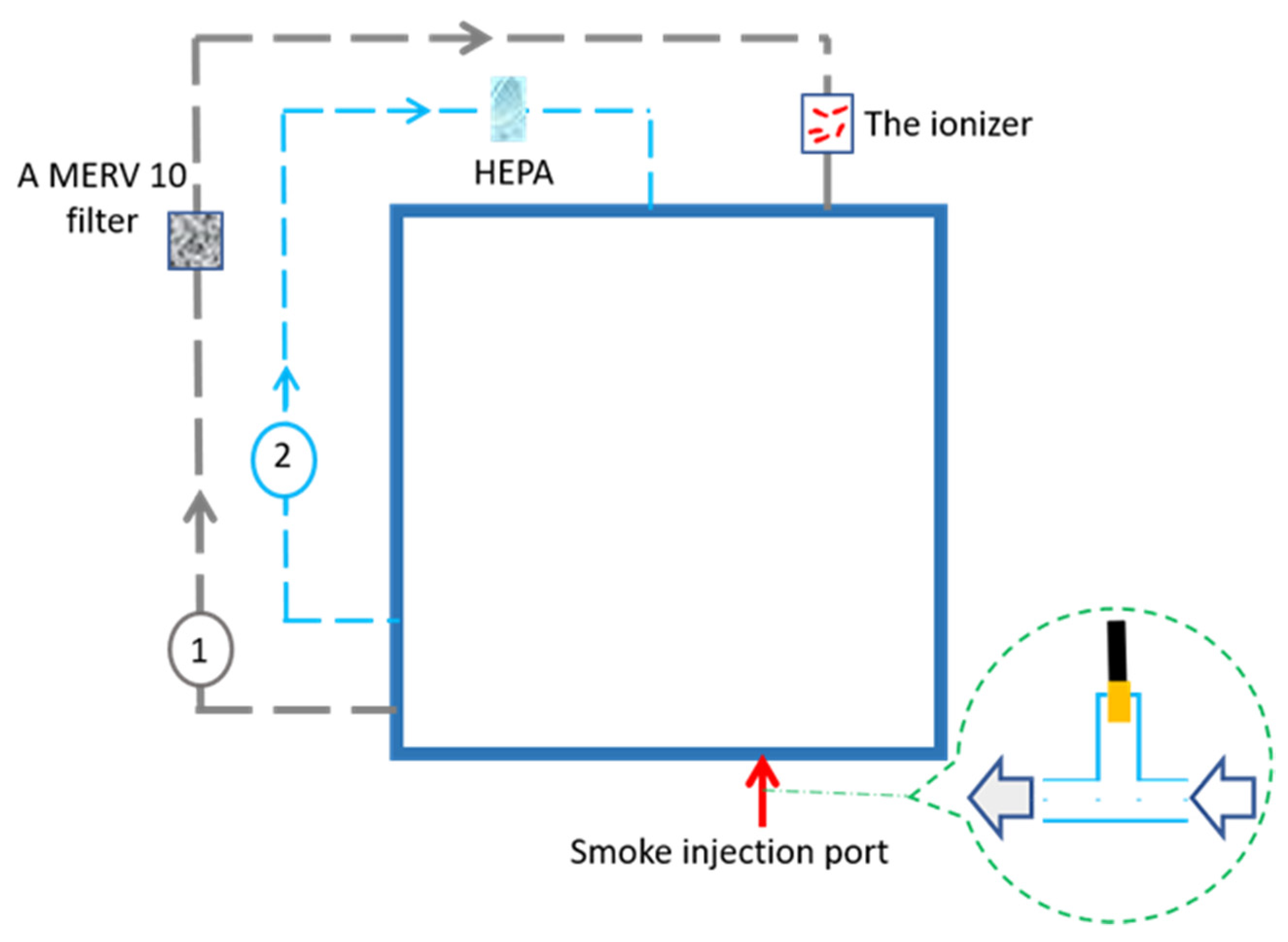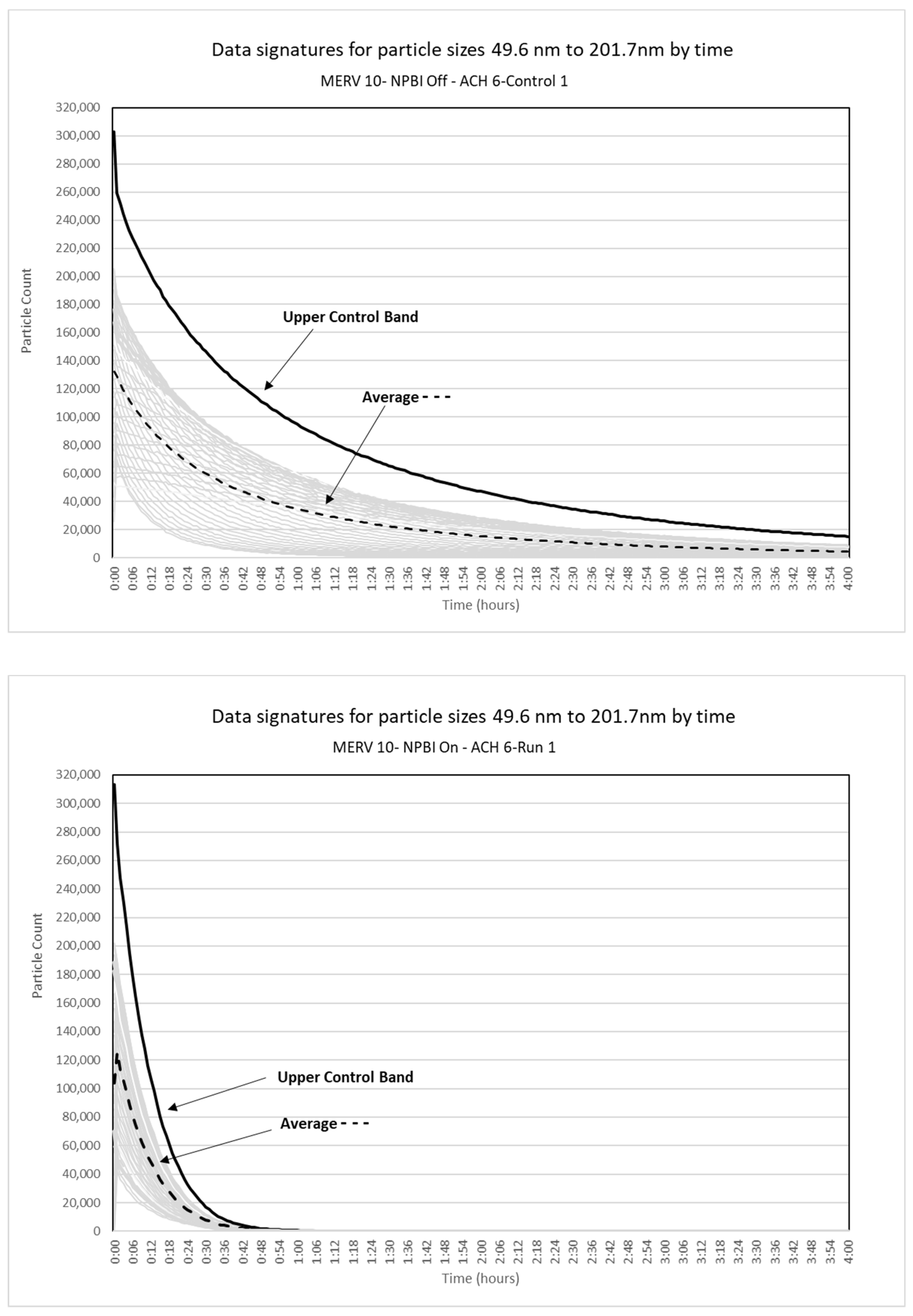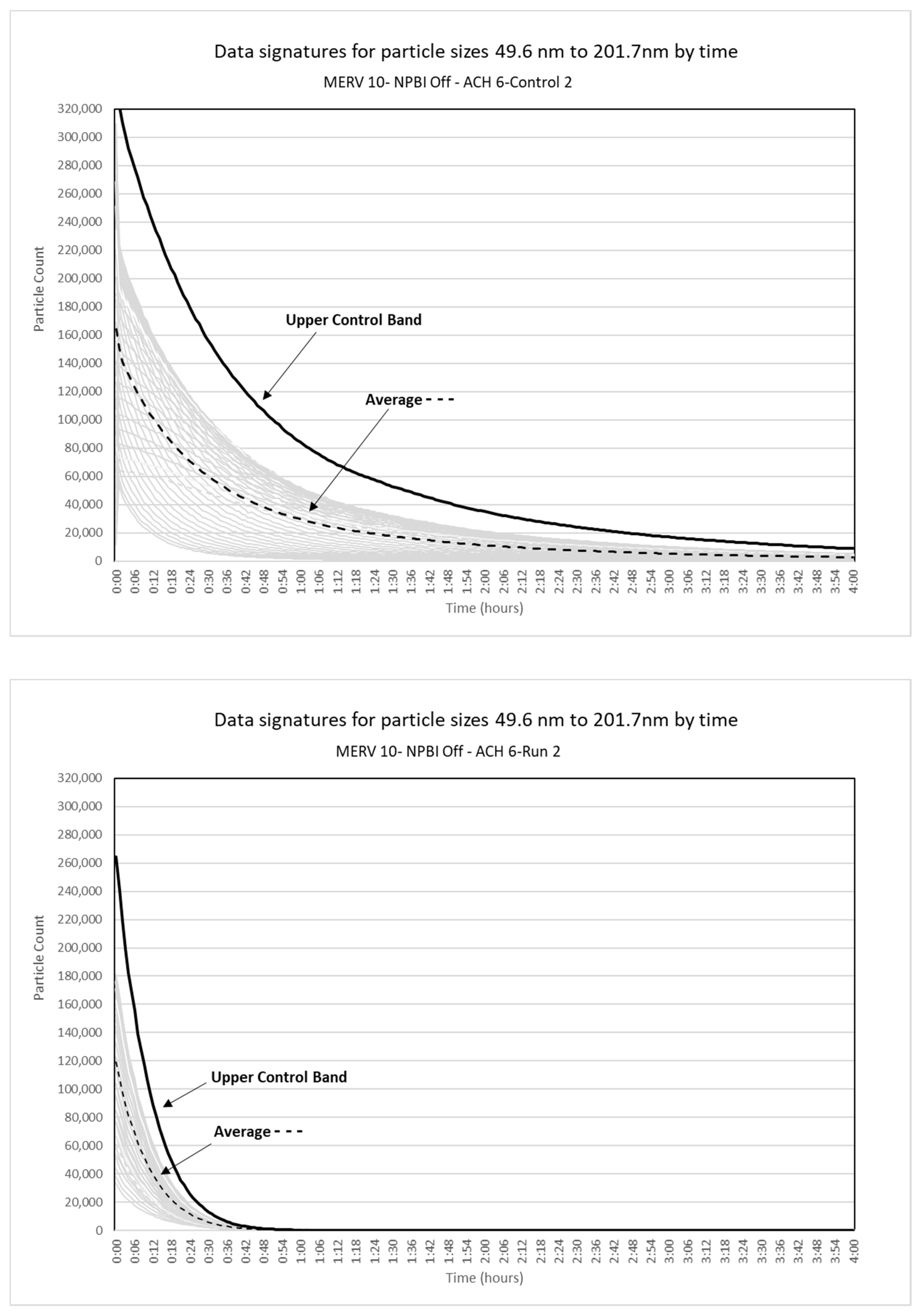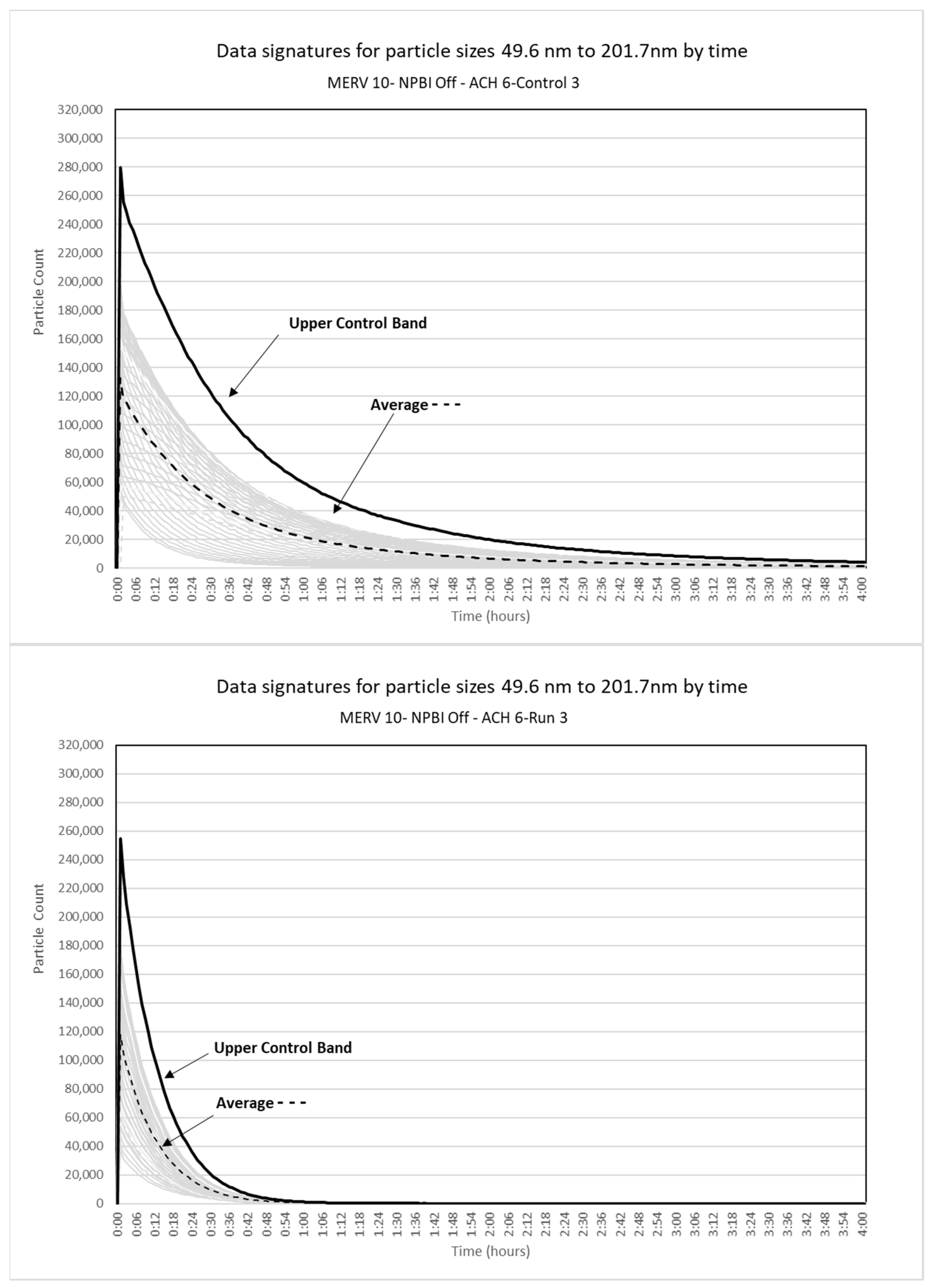Quantifying the Natural Variation of ‘Data Signatures’ from Aerosols Using Statistical Control Bands
Abstract
1. Introduction
2. Materials and Methods
2.1. Experimental Protocol and Data Description
2.2. Bonferroni Methods as Control Bands
2.3. Control-Band Application Example
3. Results and Discussion
3.1. Control Bands for Illustrating Reduction in Aerosol Particles
3.2. Validation
4. Conclusions
Author Contributions
Funding
Institutional Review Board Statement
Data Availability Statement
Acknowledgments
Conflicts of Interest
Appendix A
| Particle Size (nm) | 10th Percentile ∆ | 25th Percentile ∆ | 50th Percentile ∆ | 75th Percentile ∆ | 90th Percentile ∆ |
|---|---|---|---|---|---|
| 49.6 | −71.04 | −110.40 | −390.77 | −2327.19 | −7941.73 |
| 51.4 | −94.47 | −154.06 | −515.13 | −2866.12 | −8921.52 |
| 53.3 | −120.28 | −212.34 | −685.59 | −3489.56 | −10,456.62 |
| 55.2 | −168.64 | −287.43 | −891.62 | −4423.11 | −11,879.62 |
| 57.3 | −222.77 | −369.72 | −1141.91 | −5397.06 | −13,614.68 |
| 59.4 | −299.43 | −508.22 | −1447.55 | −6634.40 | −15,703.85 |
| 61.5 | −397.12 | −655.00 | −1940.23 | −7956.78 | −18,538.53 |
| 63.8 | −511.84 | −870.52 | −2388.81 | −9651.90 | −21,369.81 |
| 66.1 | −644.74 | −1073.14 | −2980.13 | −11,411.00 | −25,278.64 |
| 68.5 | −843.40 | −1368.72 | −3586.95 | −13,531.14 | −28,997.09 |
| 71 | −1074.77 | −1690.32 | −4425.30 | −15,868.78 | −32,530.13 |
| 73.7 | −1287.72 | −2133.25 | −5449.16 | −18,466.21 | −36,163.76 |
| 76.4 | −1659.63 | −2630.79 | −6487.57 | −21,028.19 | −40,516.38 |
| 79.1 | −1998.09 | −3135.09 | −7729.62 | −24,129.71 | −44,944.92 |
| 82 | −2447.75 | −3804.07 | −9029.73 | −27,322.32 | −49,752.36 |
| 85.1 | −2890.23 | −4468.93 | −10,393.63 | −30,593.12 | −55,138.79 |
| 88.2 | −3413.64 | −5178.10 | −12,195.61 | −34,000.29 | −59,078.32 |
| 91.4 | −3985.03 | −5983.91 | −13,472.18 | −37,418.20 | −64,041.74 |
| 94.7 | −4625.91 | −6986.15 | −15,225.33 | −40,546.26 | −68,589.45 |
| 98.2 | −5321.43 | −7907.64 | −16,934.14 | −44,242.43 | −73,005.11 |
| 101.8 | −6009.60 | −8841.32 | −18,572.26 | −47,231.16 | −76,949.83 |
| 105.5 | −6638.0598 | −9738.1785 | −20,019.212 | −50,030.865 | −79,827.0508 |
| 109.4 | −7260.0856 | −10,708.4355 | −22,107.851 | −52,774.2535 | −83,352.6688 |
| 113.4 | −7944.5814 | −11,755.6805 | −23,451.358 | −54,760.3115 | −85,782.0056 |
| 117.6 | −8525.4926 | −12,222.311 | −24,566.956 | −56,928.7355 | −86,695.7532 |
| 121.9 | −9097.8328 | −13,371.469 | −25,852.717 | −58,552.562 | −87,001.3776 |
| 126.3 | −9633.37 | −13,774.4295 | −26,518.37 | −58,951.29 | −87,466.1308 |
| 131 | −10,086.3364 | −14,445.6815 | −27,466.442 | −59,469.339 | −86,299.1056 |
| 135.8 | −10,454.558 | −14,919.71 | −27,806.089 | −59,809.7135 | −84,584.588 |
| 140.7 | −10,728.7238 | −15,200.6485 | −28,417.536 | −58,771.5575 | −81,976.032 |
| 145.9 | −10,933.4902 | −15,471.8985 | −28,521.295 | −58,004.8745 | −78,461.4664 |
| 151.2 | −11,158.636 | −15,320.821 | −28,248.641 | −56,690.793 | −75,460.6728 |
| 156.8 | −11,081.734 | −15,387.1115 | −27,981.461 | −54,348.185 | −71,642.2158 |
| 162.5 | −11,047.0906 | −15,317.4375 | −27,005.655 | −52,089.955 | −66,632.8662 |
| 168.5 | −11,000.426 | −15,081.8515 | −26,547.787 | −50,121.797 | −62,820.4778 |
| 174.7 | −10,707.8582 | −14,743.0235 | −25,564.909 | −46,899.811 | −57,608.884 |
| 181.1 | −10,372.675 | −14,169.9315 | −24,511.735 | −43,953.578 | −52,949.5296 |
| 187.7 | −10,084.4152 | −13,844.378 | −23,243.952 | −40,813.9865 | −48,049.2562 |
| 194.6 | −9712.6572 | −13,003.237 | −21,929.29 | −37,865.3625 | −43,671.703 |
| 201.7 | −9247.0406 | −12,294.2225 | −20,586.839 | −34,299.1115 | −38,978.699 |
| Particle Size (nm) | 10th Percentile ∆ | 25th Percentile ∆ | 50th Percentile ∆ | 75th Percentile ∆ | 90th Percentile ∆ |
|---|---|---|---|---|---|
| 49.6 | −72.99 | −98.07 | −254.72 | −1381.29 | −8526.55 |
| 51.4 | −81.61 | −118.87 | −314.36 | −1775.41 | −9994.18 |
| 53.3 | −106.10 | −154.82 | −447.00 | −2333.76 | −12,243.13 |
| 55.2 | −128.83 | −201.34 | −569.99 | −2950.44 | −14,895.07 |
| 57.3 | −161.58 | −257.30 | −730.78 | −3755.08 | −17,829.17 |
| 59.4 | −207.13 | −341.62 | −970.04 | −4695.17 | −21,319.92 |
| 61.5 | −265.07 | −442.57 | −1242.97 | −5758.63 | −25,191.59 |
| 63.8 | −335.49 | −567.38 | −1553.67 | −7139.61 | −29,267.16 |
| 66.1 | −434.63 | −724.28 | −1978.62 | −8640.39 | −34,134.78 |
| 68.5 | −535.44 | −875.59 | −2507.11 | −10,445.38 | −39,645.14 |
| 71 | −662.71 | −1075.42 | −3043.86 | −12,185.66 | −45,010.04 |
| 73.7 | −838.74 | −1380.85 | −3707.95 | −14,655.22 | −50,488.53 |
| 76.4 | −1030.33 | −1725.55 | −4577.33 | −16,856.24 | −56,940.54 |
| 79.1 | −1243.08 | −2057.97 | −5314.05 | −19,368.56 | −63,449.71 |
| 82 | −1497.58 | −2456.15 | −6459.98 | −22,075.95 | −70,432.79 |
| 85.1 | −1813.68 | −2994.54 | −7426.46 | −24,912.79 | −76,987.39 |
| 88.2 | −2171.54 | −3487.22 | −8505.95 | −28,051.07 | −82,814.88 |
| 91.4 | −2526.98 | −4039.38 | −9904.94 | −31,347.75 | −89,762.93 |
| 94.7 | −2921.57 | −4680.36 | −10,984.41 | −33,871.42 | −96,433.04 |
| 98.2 | −3269.62 | −5240.04 | −12,319.90 | −37,617.20 | −101,841.37 |
| 101.8 | −3683.52 | −5837.00 | −13,685.61 | −40,160.54 | −106,802.69 |
| 105.5 | −4115.82 | −6532.05 | −14,801.29 | −42,638.20 | −110,727.37 |
| 109.4 | −4529.88 | −7093.45 | −15,858.21 | −45,637.17 | −114,381.05 |
| 113.4 | −4919.74 | −7595.87 | −17,251.25 | −46,876.62 | −116,769.58 |
| 117.6 | −5261.18 | −8239.92 | −18,184.92 | −49,373.91 | −117,957.48 |
| 121.9 | −5570.80 | −8626.18 | −19,095.96 | −50,800.09 | −117,873.98 |
| 126.3 | −5931.71 | −9078.25 | −19,845.49 | −51,249.58 | −117,828.59 |
| 131 | −6276.66 | −9530.54 | −20,431.26 | −52,411.11 | −116,400.39 |
| 135.8 | −6449.72 | −9737.45 | −20,753.98 | −52,533.78 | −113,065.90 |
| 140.7 | −6718.03 | −9959.95 | −20,780.85 | −51,847.55 | −110,365.79 |
| 145.9 | −6721.06 | −10,101.94 | −20,987.74 | −51,361.59 | −107,115.27 |
| 151.2 | −6808.33 | −10,058.76 | −20,767.13 | −49,762.55 | −102,544.98 |
| 156.8 | −6695.00 | −10,073.95 | −20,411.35 | −48,121.84 | −96,907.51 |
| 162.5 | −6689.10 | −9924.63 | −20,111.96 | −46,806.88 | −90,800.95 |
| 168.5 | −6657.67 | −9649.03 | −19,467.87 | −44,218.97 | −84,491.30 |
| 174.7 | −6302.08 | −9446.86 | −18,744.15 | −41,863.46 | −78,366.51 |
| 181.1 | −6080.47 | −9107.01 | −17,676.41 | −39,103.33 | −71,418.07 |
| 187.7 | −5914.77 | −8601.26 | −16,767.97 | −36,181.91 | −65,110.73 |
| 194.6 | −5572.47 | −8140.88 | −15,812.27 | −33,320.63 | −58,949.09 |
| 201.7 | −5244.68 | −7549.18 | −14,767.78 | −30,608.12 | −52,578.17 |
| Particle Size (nm) | 10th Percentile ∆ | 25th Percentile ∆ | 50th Percentile ∆ | 75th Percentile ∆ | 90th Percentile ∆ |
|---|---|---|---|---|---|
| 49.6 | −42.01 | −59.05 | −192.70 | −1150.37 | −3243.39 |
| 51.4 | −46.92 | −67.50 | −256.20 | −1466.21 | −3812.91 |
| 53.3 | −59.98 | −97.36 | −350.02 | −1826.78 | −4940.51 |
| 55.2 | −78.74 | −125.26 | −452.40 | −2358.19 | −6151.12 |
| 57.3 | −99.76 | −163.28 | −596.78 | −2924.58 | −7642.69 |
| 59.4 | −135.22 | −213.22 | −759.75 | −3694.62 | −9598.77 |
| 61.5 | −160.72 | −294.71 | −977.38 | −4677.69 | −11,526.04 |
| 63.8 | −207.17 | −373.84 | −1193.95 | −5690.38 | −14,027.99 |
| 66.1 | −272.79 | −464.93 | −1495.77 | −6950.09 | −16,164.37 |
| 68.5 | −347.44 | −589.43 | −1846.59 | −8407.21 | −19,362.07 |
| 71 | −413.63 | −725.94 | −2202.45 | −9789.13 | −22,508.44 |
| 73.7 | −509.81 | −867.32 | −2779.11 | −11,611.99 | −26,830.16 |
| 76.4 | −633.69 | −1061.96 | −3164.44 | −13,072.63 | −30,574.35 |
| 79.1 | −746.62 | −1271.87 | −3819.73 | −15,253.56 | −34,972.60 |
| 82 | −894.34 | −1518.81 | −4475.13 | −17,408.65 | −39,150.64 |
| 85.1 | −1051.86 | −1815.41 | −5037.52 | −19,715.19 | −42,905.91 |
| 88.2 | −1236.28 | −2097.16 | −5904.75 | −21,622.09 | −47,870.61 |
| 91.4 | −1419.62 | −2364.24 | −6538.48 | −23,930.74 | −51,889.95 |
| 94.7 | −1652.13 | −2705.00 | −7252.63 | −25,837.96 | −55,997.60 |
| 98.2 | −1822.42 | −2970.15 | −7972.94 | −27,722.24 | −59,581.36 |
| 101.8 | −2033.15 | −3287.49 | −8635.91 | −29,853.20 | −63,075.72 |
| 105.5 | −2213.18 | −3551.09 | −9288.01 | −31,498.72 | −66,181.24 |
| 109.4 | −2426.54 | −3880.67 | −9826.22 | −33,181.41 | −67,517.56 |
| 113.4 | −2566.59 | −4080.64 | −10,453.57 | −34,170.78 | −70,230.08 |
| 117.6 | −2788.63 | −4419.80 | −11,023.52 | −35,222.66 | −70,395.14 |
| 121.9 | −2894.43 | −4616.59 | −11,276.74 | −36,007.49 | −71,347.17 |
| 126.3 | −2949.58 | −4792.10 | −11,665.41 | −36,616.51 | −71,245.98 |
| 131 | −3064.46 | −4871.11 | −11,796.69 | −36,588.28 | −71,189.89 |
| 135.8 | −3139.23 | −4914.68 | −11,961.62 | −36,031.76 | −69,543.38 |
| 140.7 | −3208.35 | −4933.77 | −11,777.74 | −35,745.13 | −67,554.10 |
| 145.9 | −3251.97 | −4935.99 | −11,623.55 | −34,436.17 | −65,404.10 |
| 151.2 | −3234.05 | −4869.98 | −11,630.35 | −33,482.29 | −62,266.87 |
| 156.8 | −3139.56 | −4830.75 | −11,205.00 | −32,194.32 | −58,439.25 |
| 162.5 | −3052.82 | −4692.30 | −10,718.82 | −30,439.31 | −55,035.60 |
| 168.5 | −2953.02 | −4470.65 | −10,317.88 | −28,712.20 | −50,717.31 |
| 174.7 | −2849.67 | −4275.40 | −9610.28 | −26,705.96 | −47,050.88 |
| 181.1 | −2679.22 | −4064.75 | −9218.12 | −24,568.90 | −43,509.09 |
| 187.7 | −2608.86 | −3794.06 | −8279.37 | −22,422.52 | −39,661.92 |
| 194.6 | −2348.86 | −3487.20 | −7762.06 | −20,490.99 | −35,093.05 |
| 201.7 | −2158.10 | −3207.08 | −7023.20 | −18,551.42 | −31,648.98 |
References
- Portz, A.; Bomhardt, K.; Rohnke, M.; Schneider, P.; Asperger, A.; Gebhardt, C.R.; Dürr, M. Soft cluster-induced desorption/ionization mass spectrometry: How soft is soft? Biointerphases 2020, 15, 021001. [Google Scholar] [CrossRef]
- Deming, W.E. On Probability as a Basis for Action. Am. Stat. 1975, 29, 146–152. [Google Scholar] [CrossRef]
- Deming, W.E. Out of the Crisis; Massachusetts Institute of Technology, Center for Advanced Engineering Study: Cambridge, MA, USA, 1986. [Google Scholar]
- Shewhart, W.A. Economic Control of Quality of Manufactured Product; Van Nostrand: New York, NY, USA, 1931. [Google Scholar]
- Wong, P.C.; Foote, H.; Leung, R.; Adams, D.; Thomas, J. Data signatures and visualization of scientific data sets. IEEE Comput. Graph. Appl. 2000, 20, 12–15. [Google Scholar] [CrossRef][Green Version]
- Achraf Cohen, A.; Atoui, M.A. On wavelet-based statistical process monitoring. Trans. Inst. Meas. Control 2022, 44, 525–538. [Google Scholar] [CrossRef]
- Atoui, M.A.; Verron, S.; Kobi, A. A Bayesian network dealing with measurements and residuals for system monitoring. Trans. Inst. Meas. Control 2016, 38, 373–384. [Google Scholar] [CrossRef]
- Chiang, L.H.; Braatz, R.D.; Russell, E. Fault Detection and Diagnosis in Industrial Systems; Springer: London, UK, 2001. [Google Scholar]
- Yin, S.; Ding, S.X.; Xie, X.; Luo, H. A review on basic data driven approaches for industrial process monitoring. IEEE Trans. Ind. Electron. 2014, 61, 6418–6428. [Google Scholar] [CrossRef]
- Liao, Y.; Deschamps, F.; de Freitas Rocha, L.E.; Pierin Ramos, L.F. Past, present and future of Industry 4.0—A systematic literature review and research agenda proposal. Int. J. Prod. Res. 2017, 55, 3609–3629. [Google Scholar] [CrossRef]
- Isermann, R. Fault-Diagnosis Systems: An Introduction from Fault Detection to Fault Tolerance; Springer: Berlin/Heidelberg, Germany, 2006. [Google Scholar]
- Shi, R.-z.; Liu, F. Statistical process control based on multi-scale wavelets analysis. In Proceedings of the IEEE International Symposium on Knowledge Acquisition and Modeling Workshop, Wuhan, China, 21–22 December 2008; pp. 136–138. [Google Scholar] [CrossRef]
- Jeong, M.K.; Lu, J.-C.; Wang, N. Wavelet-based SPC procedure for complicated functional data. Int. J. Prod. Res. 2006, 44, 729–744. [Google Scholar] [CrossRef]
- Ceriolo, A.; Laurini, F.; Corbellini, A. Functional cluster analysis of financial time series. In Proceedings of the Classification and Data Analysis Group of the Italian Statistical Society, Bologna, Italy, 22–24 September 2003. [Google Scholar]
- Woodall, W.H. Controversies and contradictions in statistical process control. J. Qual. Technol. 2000, 32, 341–350. [Google Scholar] [CrossRef]
- Woodall, W.H.; Spitzner, D.J.; Montgomery, D.C.; Gupta, S. Using control charts to monitor process and product quality profiles. J. Qual. Technol. 2004, 36, 309–320. [Google Scholar] [CrossRef]
- Morris, J.S.; Arroyo, C.; Coull, B.A.; Ryan, L.M. Using wavelet-based functional mixed models to characterize population heterogeneity in accelerator profiles: A case study. J. Am. Stat. Assoc. 2006, 101, 1352–1364. [Google Scholar] [CrossRef]
- Bertran, E.; Blanco, M.; Maspoch, S.; Ortiz, M.C.; Sanchez, M.S.; Sarabia, L.A. Handling intrinsic non-linearity in near-infrared reflectance spectroscopy. Chemom. Intell. Lab. Syst. 1999, 49, 215–224. [Google Scholar] [CrossRef]
- Bowman, A.; Young, S. Graphical comparison of nonparametric curves. Appl. Stat. 1996, 45, 83–98. [Google Scholar] [CrossRef]
- Colosimo, B.M.; Semeraro, Q.; Pacella, M. Statistical process control for geometric specifications: On monitoring of roundness profiles. J. Qual. Technol. 2008, 40, 1–18. [Google Scholar] [CrossRef]
- Kim, K.; Mahmoud, M.A.; Woodall, W.H. On the monitoring of linear profiles. J. Qual. Technol. 2003, 35, 317–328. [Google Scholar] [CrossRef]
- Sanchez, M.S.; Bertran, E.; Sarabia, L.A.; Ortiz, M.C.; Blanco, M.; Coello, J. Quality control decisions with near infrared data. Chemom. Intell. Lab. Syst. 2000, 53, 69–80. [Google Scholar] [CrossRef]
- Duan, M.; Wang, L.; Meng, X.; Fu, L.; Wang, Y.; Liang, W.; Liu, L. Negative Ion Purifier Effects on Indoor Particulate Dosage to Small Airways. Int. J. Environ. Res. Public Health 2021, 19, 264. [Google Scholar] [CrossRef]
- Klepeis, N.E.; Nelson, W.C.; Ott, W.R.; Robinson, J.P.; Tsang, A.M.; Switzer, P.; Behar, J.V.; Hern, S.C.; Engelmann, W.H. The National Human Activity Pattern Survey (NHAPS): A resource for assessing exposure to environmental pollutants. J. Expo. Sci. Environ. Epidemiol. 2001, 11, 231–252. [Google Scholar] [CrossRef]
- Hvelplund, M.H.; Liu, L.; Frandsen, K.M.; Qian, H.; Nielsen, P.V.; Dai, Y.; Wen, L.; Zhang, Y. Numerical investigation of the lower airway exposure to indoor particulate contaminants. Indoor Built Environ. 2020, 29, 575–586. [Google Scholar] [CrossRef]
- Lim, S.S.; Vos, T.; Flaxman, A.D.; Danaei, G.; Shibuya, K.; Adair-Rohani, H.; Almazroa, M.A.; Amann, M.; Anderson, H.R.; Andrews, K.G.; et al. A comparative risk assessment of burden of disease and injury attributable to 67 risk factors and risk factor clusters in 21 regions, 1990–2010: A systematic analysis for the Global Burden of Disease Study 2010. Lancet 2012, 380, 2224–2260. [Google Scholar] [CrossRef]
- World Health Organization. World Report on Knowledge for Better Health: Strengthening Health Systems; World Health Organization: Geneva, Switzerland, 2004.
- Sérafin, G.; Blondeau, P.; Mandin, C. Indoor air pollutant health prioritization in office buildings. Indoor Air 2021, 31, 646–659. [Google Scholar] [CrossRef]
- Rudnick, S.N. Optimizing the Design of Room Air Filters for the Removal of Submicrometer Particles. Aerosol Sci. Technol. 2004, 38, 861–869. [Google Scholar] [CrossRef]
- Ng, B.F.; Xiong, J.W.; Wan, M.P. Application of acoustic agglomeration to enhance air filtration efficiency in air-conditioning and mechanical ventilation (ACMV) systems. PLoS ONE 2017, 12, e0178851. [Google Scholar] [CrossRef]
- Černecký, J.; Valentová, K.; Pivarčiová, E.; Božek, P. Ionization Impact on the Air Cleaning Efficiency in the Interior. Meas. Sci. Rev. 2015, 15, 156–166. [Google Scholar] [CrossRef]
- Grabarczyk, Z. Effectiveness of indoor air cleaning with corona ionizers. J. Electrost. 2001, 51, 278–283. [Google Scholar] [CrossRef]
- Park, J.H.; Yoon, K.Y.; Hwang, J. Removal of submicron particles using a carbon fiber ionizer-assisted medium air filter in a heating, ventilation, and air-conditioning (HVAC) system. Build. Environ. 2011, 46, 1699–1708. [Google Scholar] [CrossRef]
- Park, J.H.; Yoon, K.Y.; Kim, Y.S.; Byeon, J.H.; Hwang, J. Removal of submicron aerosol particles and bioaerosols using carbon fiber ionizer assisted fibrous medium filter media. J. Mech. Sci. Technol. 2009, 23, 1846–1851. [Google Scholar] [CrossRef]
- Pushpawela, B.; Jayaratne, R.; Nguy, A.; Morawska, L. Efficiency of ionizers in removing airborne particles in indoor environments. J. Electrost. 2017, 90, 79–84. [Google Scholar] [CrossRef]
- Young, T.M.; Khaliukova, O.; André, N.; Petutschnigg, A.; Rials, T.G.; Chen, C.-H. Detecting special-cause variation ‘events’ from process data signatures. J. Appl. Stat. 2019, 46, 3032–3043. [Google Scholar] [CrossRef]
- Stephens, B.; Siegel, J.A. Ultrafine particle removal by residential heating, ventilating, and air-conditioning filters. Indoor Air 2013, 23, 488–497. [Google Scholar] [CrossRef]
- Wagner, K.; Higby, R.; Stutt, K. Puff-by-Puff Analysis of Selected Mainstream Smoke Constituents in The Kentucky Reference 2R4F Cigarette. Contrib. Tob. Res. 2005, 21, 273–279. [Google Scholar] [CrossRef][Green Version]
- Härdle, W. Applied Nonparametric Regression; Cambridge University Press: Cambridge, UK, 1990. [Google Scholar]
- Milton, J.S.; Arnold, J.C. Introduction to Probability and Statistics: Principles and Applications for Engineering and the Computing Sciences; McGraw-Hill: New York, NY, USA, 2003. [Google Scholar]
- Hahn, G.J.; Meeker, W.Q.; Escobar, L.A. Statistical Intervals: A Guide for Practitioners and Researchers, 2nd ed.; John Wiley & Sons, Incorporated: Chicester, UK, 2017. [Google Scholar]
- Fisher, N. Graphical Methods in Statistics: Current and Prospective Views; CSIRO: Canberra, Australia, 1987.





| Group | Particle Sizes (nm) | Pdf Best Fit | AIC Range 1 | BIC Range 2 |
|---|---|---|---|---|
| Control 1 | 49.6–85.1 | Generalized Gamma | 4052.65–5304.14 | 4063.00–5314.50 |
| Control 1 | 88.2–101.8 | Frechet | 5350.91–5493.10 | 4151.63–5500.02 |
| Control 1 | 105.5–201.7 | Log-Generalized Gamma | 5513.84–5168.65 | 4259.64–5179.00 |
| Treatment 1 | 49.6–201.7 | Generalized Gamma | 2766.23–3205.33 | 2776.58–3215.68 |
| Control 2 | 49.6–94.7 | Generalized Gamma | 3799.91–5367.62 | 3810.03–5377.97 |
| Control 2 | 98.2–131 | Frechet | 5406.52–5544.93 | 5413.44–5551.85 |
| Control 2 | 135.8–201.7 | Log-Generalized Gamma | 5505.32–5195.92 | 5551.47–5606.27 |
| Treatment 2 | 49.6–201.7 | Generalized Gamma | 2619.74–4250.55 | 2630.09–4260.91 |
| Control 3 | 49.6–109.4 | Generalized Gamma | 3757.70–5335.38 | 3768.05–5345.73 |
| Control 3 | 113.4–168.5 | Frechet | 5351.3–5238.06 | 5358.22–5244.98 |
| Control 3 | 174.7–201.7 | Log-Generalized Gamma | 5199.59–4281.52 | 5209.95–2712.65 |
| Treatment 3 | 49.6–201.7 | Generalized Gamma | 2886.96–4275.21 | 2897.31–4291.87 |
| Simulated Data Signatures | Gaussian pdf | ||||
| 90th | 95th | 99th | 99.7th | 100th | |
| 100 | 0 | 0 | 0 | 0 | 2 |
| 500 | 0 | 0 | 0 | 0 | 5 (0.5%) |
| 1000 | 0 | 0 | 10 (0.1%) | 10 (0.1%) | 47 (0.5%) |
| Generalized Gamma pdf | |||||
| 90th | 95th | 99th | 99.7th | 100th | |
| 100 | 12 | 6 | 3 | 2 | 2 |
| 500 | 23 (4.6%) | 7 (1.4%) | 3 (0.6%) | 3 (0.6%) | 3 (0.6%) |
| 1000 | 59 (5.9%) | 19 (1.9%) | 9 (0.9%) | 7 (0.7%) | 7 (0.7%) |
Publisher’s Note: MDPI stays neutral with regard to jurisdictional claims in published maps and institutional affiliations. |
© 2022 by the authors. Licensee MDPI, Basel, Switzerland. This article is an open access article distributed under the terms and conditions of the Creative Commons Attribution (CC BY) license (https://creativecommons.org/licenses/by/4.0/).
Share and Cite
Young, T.M.; Sobek, E.; Farahi, F. Quantifying the Natural Variation of ‘Data Signatures’ from Aerosols Using Statistical Control Bands. Mathematics 2022, 10, 2103. https://doi.org/10.3390/math10122103
Young TM, Sobek E, Farahi F. Quantifying the Natural Variation of ‘Data Signatures’ from Aerosols Using Statistical Control Bands. Mathematics. 2022; 10(12):2103. https://doi.org/10.3390/math10122103
Chicago/Turabian StyleYoung, Timothy M., Edward Sobek, and Faramarz Farahi. 2022. "Quantifying the Natural Variation of ‘Data Signatures’ from Aerosols Using Statistical Control Bands" Mathematics 10, no. 12: 2103. https://doi.org/10.3390/math10122103
APA StyleYoung, T. M., Sobek, E., & Farahi, F. (2022). Quantifying the Natural Variation of ‘Data Signatures’ from Aerosols Using Statistical Control Bands. Mathematics, 10(12), 2103. https://doi.org/10.3390/math10122103





